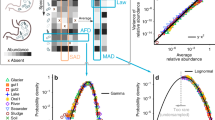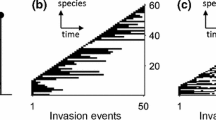Abstract
It is shown from the statistical-mechanical overview of Volterra's ecological model how to reckon the fluctuations of collective variables such as the total population of a genus: and that these fluctuations are much decreased (or that the collective populationsteadiness is enhanced) as the speciation is increased. (A niching of species in time, or phase-niching, is entailed here.) Secondly, it is shown how Preston's log-normal distribution describing the species-abundance relationship, as well as a generalization of such distributions, come forth simply and naturally from the statistical-Volterra-dynamics.
Similar content being viewed by others
Literature
Brookhaven National Laboratory. 1969. Symposium Report,Diversity and Stability in Ecological Systems. Springfield, Virginia: U.S. Department of Commerce.
Feller, W. 1971.An Introduction to Probability Theory and Its Applications. New York: Wiley, Vol. II.
Goel, N. S., S. C. Maitra and E. W. Montroll. 1971. “On the Volterra and Other Nonlinear Models of Interacting Populations”.Rev. Mod. Phys.,43, 231–276.
Hutchinson, G. E. 1959. “Homage to Santa Rosalia, or, Why Are There So Many Kinds of Animals?”Amer. Naturalist,93, 145–156.
Kerner, E. H. 1957. “A Statistical Mechanics of Interacting Biological Species”.Bull. Math. Biophysics,19, 121–146.
— 1959. “Further Considerations on the Statistical Mechanics of Biological Associations”.,21, 217–255.
— 1972.Gibbs Ensemble: Biological Ensemble.. New York: Gordon and Breach.
Preston, F. W. 1948. “The Commonness, and Rarity of Species”Ecology,29, 254–283.
— 1962. “The Canonical Distribution of Commonness and Rarity”.,43, 185–215, 410–432.
Volterra, V. 1931.Lecons sur la Theorie Mathematique de la Lutte pour la Vie. Paris: Gauthier-Villars.
Whittaker, R. H. 1970.Communities and Ecosystems. New York: Macmillan.
Williams, C. B. 1964.Patterns in the Balance of Nature. New York: Academic Press.
Author information
Authors and Affiliations
Rights and permissions
About this article
Cite this article
Kerner, E.H. Why are there so many species?. Bltn Mathcal Biology 36, 477–488 (1974). https://doi.org/10.1007/BF02463261
Received:
Issue Date:
DOI: https://doi.org/10.1007/BF02463261




